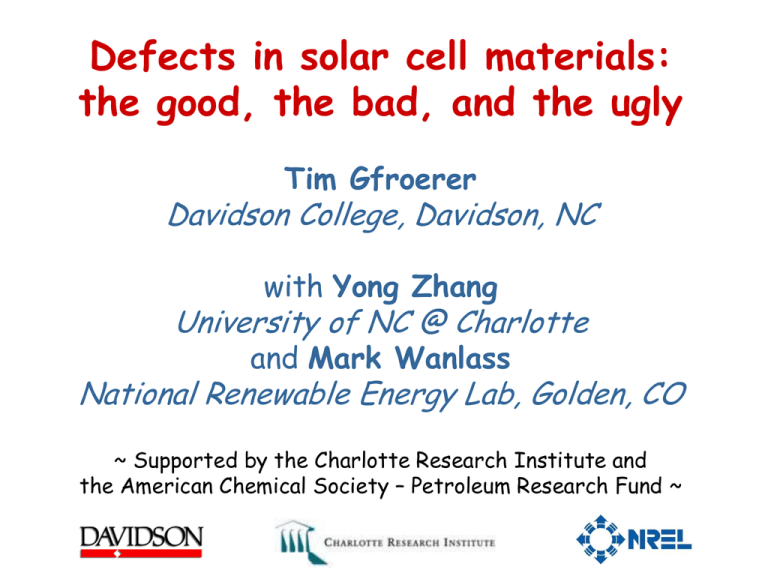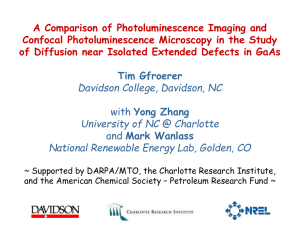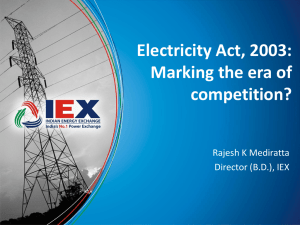Defects in solar cell materials: the good, the bad
advertisement

Defects in solar cell materials: the good, the bad, and the ugly Tim Gfroerer Davidson College, Davidson, NC with Yong Zhang University of NC @ Charlotte and Mark Wanlass National Renewable Energy Lab, Golden, CO ~ Supported by the Charlotte Research Institute and the American Chemical Society – Petroleum Research Fund ~ Some of the experiments and analysis by . . . Mac Read and Caroline Vaughan (’10) Ryan Crum and Mark Crowley (’11) Outline • Semiconductors, solar cells, and defects • Recombination, radiative efficiency, and dependence on defect level distributions • Photoluminescence imaging and modeling • Confocal photoluminescence microscopy and the role of diffusion Semiconductors a free atoms V(r) r atomic crystal Energy levels Spacing decreasing n=3 n=2 Periodic Potential Physlet* * Physlet Quantum Physics: An Interactive Introduction by Mario Belloni et al. (2006). n=1 - a Solar Cell Operation Conduction Band - E-Field - HEAT ELECTRON ABSORPTION PHOTON CURRENT HOLE - Valence Band + E-Field + + + When a photon is absorbed, an electron is excited into the conduction band, leaving a hole behind in the valence band. Some heat is lost, reducing efficiency. Then an internal electric field sweeps the electrons and holes away, creating electricity. Good Defects: Impurities for p/n Junction Formation + + + ++ + + + + + + + + P+ + + + + + + + + + + + + + + + - + - Depletion Layer ← E-Field ← - - N - Semiconductor Defects Defect Level Physlet ~ from Physlet Quantum Physics: An Interactive Introduction by Mario Belloni et al. (2006). Dislocation Applet Bad Defects: Defect-Related Trapping and Recombination Conduction Band ENERGY - Defect Level HEAT HEAT + Valence Band Electrons can recombine with holes by hopping through defect levels and releasing more heat. This loss mechanism also reduces the efficiency of a solar cell. Radiative Recombination and Efficiency Conduction Band - light in PHOTON + Valence Band Radiative Rate ~ n x p heat light out Radiative Efficiency = (light out) / (light in) = (radiative rate) / (total recombination rate) Photoluminescence Imaging Experiment Excitation-Dependent Images 2 2 Sample (b) Iex ~ 1.2 W/cm (a) Iex ~ 12 W/cm Laser Lowpass filter 100 m 1.00 0.90 0.92 0.83 0.83 0.75 0.75 0.68 100 m 0.60 0.66 2 Camera 2 (c) Iex ~ 0.12 W/cm 100 m (d) Iex ~ 0.012 W/cm 0.75 0.30 0.69 0.28 0.63 0.25 0.56 0.23 0.50 100 m 0.20 Top View of Diffusion to Dislocations Simulated Images Experiment Simulation 2 2 2 100 m (b) Iex ~ 1.2 W/cm 1.00 0.90 1.00 0.90 0.92 0.83 0.92 0.83 0.83 0.75 0.83 0.75 0.68 0.75 0.68 0.60 0.66 0.60 0.75 100 m 0.66 2 2 2 (c) Iex ~ 0.12 W/cm 100 m 2 (a) Iex ~ 12 W/cm (b) Iex ~ 1.2 W/cm (a) Iex ~ 12 W/cm 2 (c) Iex ~ 0.12 W/cm (d) Iex ~ 0.012 W/cm (d) Iex ~ 0.012 W/cm 0.75 0.30 0.75 0.30 0.69 0.28 0.69 0.27 0.63 0.25 0.63 0.24 0.56 0.23 0.56 0.21 0.20 0.50 0.18 0.50 100 m Simulation Details 1st Simulation 2nd Simulation Generation, recombination, and diffusion with augmented defect-related recombination in dislocation pixel: n (t ) t Generation rate Defect Radiative recombinat ion recombinat ion Diffusion rate rate d ( n ) 2 LaplacianD iffusion D n dx 2 Recombination Assumptions: 1. Defect levels clustered near the middle of the gap – no thermal excitation out of traps 2. (# of electrons) = (# of holes) = n Theoretical Efficiency: Theoretical Efficiency: Efficiency RadiativeR ate DefectRate RadiativeR ate Recombination Improvements: 1. Defect level distribution can be tailored to achieve the best fit 2. Theory accounts for thermal excitation out of traps 3. (# of e-s in conduction band) = n can differ from (# of holes in valence band) = p 4. (# of trapped e-s) = dn can differ from (# of trapped holes) = dp Efficiency Bn 2 An Bn 2 Bn p A ( n dp p dn ) B n p Better Simulated Images Experiment Simulation 1.00 0.90 0.92 0.83 0.83 0.75 0.75 0.68 100 m 2 100 m 1.00 0.90 0.92 0.83 0.83 0.75 0.75 0.68 0.66 0.60 0.60 0.66 2 2 (d) Iex ~ 0.012 W/cm (c) Iex ~ 0.12 W/cm 2 (c) Iex ~ 0.12 W/cm (b) Iex ~ 1.2 W/cm (a) Iex ~ 12 W/cm (b) Iex ~ 1.2 W/cm 100 m 2 2 2 2 (a) Iex ~ 12 W/cm (d) Iex ~ 0.012 W/cm 0.75 0.30 0.69 0.28 0.75 0.30 0.63 0.25 0.69 0.28 0.23 0.63 0.25 0.56 0.56 0.23 0.50 0.20 0.50 0.20 100 m 10 15 10 10 -3 -1 Density of States (cm eV ) The Defect-Related Density of States 10 5 -0.4 Valence Band -0.2 0.0 0.2 Fractional Bandgap Energy 0.4 Conduction Band The distribution of defect levels within the bandgap can be represented by a density of states (DOS) function as shown above. Defect-Related Density of States Used for Better Simulation (a) Dislocation Pixel (b) Bulk Pixels 8 2x10 6 6x10 -3 -1 -1 DOS / (cm eV s ) 8 2x10 6 4x10 8 1x10 6 2x10 7 5x10 0 0 Ec Ev -0.6 -0.3 0.0 0.3 0.6 Fractional Bandgap Energy Ev -0.6 Ec -0.3 0.0 0.3 0.6 Fractional Bandgap Energy Confocal Photoluminescence Microscopy Photoluminescence Contrast Contrast Experiment Mirror Bulk _ Signal Local _ Signal Bulk _ Signal Lens Lens Spectrometer Notch Filter Laser Aperture Contrast Map Lens 1.00 0.75 Sample Translation Stage 0.50 0.25 5 m 0 20 microns Confocal Maps Before 2 2 (b) Iex ~ 78 KW/cm (a) Iex ~ 650 KW/cm 0.050 0.25 0.038 0.19 0.025 0.13 0.012 5 m 0.06 5 m 0 0 2 2 (c) Iex ~ 6.2 KW/cm (d) Iex ~ 0.9 KW/cm 0.45 0.008 0.34 0.006 0.23 0.004 0.11 5 m 0 5 m 0.002 0 Confocal Maps Before After: Ugly Defects! 2 2 2 2 (b) Iex ~ 78 KW/cm (a) Iex ~ 650 KW/cm (b) Iex ~ 78 KW/cm (a) Iex ~ 650 KW/cm 5 m 5 m 0.25 0.038 0.19 0.03 0.15 0.025 0.13 0.02 0.10 0.06 0.01 0.05 0 0 0 0.012 5 m 5 m 0 2 2 2 (c) Iex ~ 6.2 KW/cm 5 m 0.20 0.050 0.04 2 (c) Iex ~ 6.2 KW/cm (d) Iex ~ 0.9 KW/cm 5 m (d) Iex ~ 0.9 KW/cm 5 m 0.25 0.004 0.006 0.19 0.003 0.23 0.004 0.13 0.002 0.11 0.002 0.06 0.001 0 0 0 0.45 0.008 0.34 0 5 m Confocal Maps of an Ugly Defect High Magnification (b) Iex ~ 6.2 KW/cm (a) Iex ~ 25 KW/cm (b) Iex ~ 78 KW/cm 20 m 5 m 5 m 2 2 2 2 (a) Iex ~ 650 KW/cm 20 m 0.04 0.20 0.8 0.45 0.03 0.15 0.6 0.34 0.02 0.10 0.4 0.23 0.01 0.05 0.2 0.11 0 0 0 0 2 2 2 (c) Iex ~ 6.2 KW/cm 5 m Low Magnification 5 m 2 (c) Iex ~ 2 KW/cm (d) Iex ~ 0.9 KW/cm (d) Iex ~ 0.9 KW/cm 20 m 20 m 0.25 0.004 0.100 0.008 0.19 0.003 0.075 0.006 0.13 0.002 0.050 0.004 0.06 0.001 0.025 0.002 0 0 0 0 Radial Contrast Profile 650 78 25 6 2 0.9 Contrast 1 2 KW/cm 2 KW/cm 2 KW/cm 2 KW/cm 2 KW/cm 2 KW/cm 0.1 0.01 0 10 20 30 40 Distance (microns) 50 Radial Contrast Profile 650 78 25 6 2 0.9 0.9 KW/cm 2 2 KW/cm 1 2 Contrast Contrast 1 2 KW/cm 2 KW/cm 2 KW/cm 2 KW/cm 2 KW/cm 2 KW/cm 0.1 0.1 0.01 0 10 20 30 40 Distance (microns) 50 0 20 40 60 Distance (microns) 80 Effective Diffusion Length Diffusion Length (microns) after before 10 1 3 10 4 5 10 10 2 Excitation (KW/cm ) 6 10 Effective Diffusion Length Diffusion Length (microns) after before Electrons? 10 Holes? 1 3 10 4 5 10 10 2 Excitation (KW/cm ) 6 10 Top View of Confocal Measurement with Diffusion to a Dislocation Low-Excitation +P P +P - L P + P P D P Excitation & Detection - P + P P P P Mid-Excitation - P P P D Dislocation +P +P +P P P Pt. Defect - +P - P - +P D - L - +P - P P Electron P + Hole Top View of Confocal Measurement with Diffusion to a Dislocation High-Excitation Mid-Excitation + P +P +P + P +P P - +P - P - +P D - L - +P Excitation & Detection - + - ++ -+ P + - - + L - -+ + - + P + --+P - P P D P P P P P P D Dislocation P P P P P Pt. Defect - Electron P + Hole Side View of a Solar Cell Under High Illumination PHOTONS DISLOCATIONS ELECTRICITY! + p/n Junction E-Field - + - Side View of a Solar Cell Under Low Illumination DISLOCATIONS PHOTONS OK LOST! + p/n Junction E-Field - + - Conclusions • Defects reduce solar cell efficiency by providing new recombination pathways (loss) • Photoluminescence is a powerful tool for examining the properties of defects • Depletion of electrons and holes near dislocations depends strongly on illumination • The physics of confocal microscopy differs dramatically from the physics of imaging • Ultimately, understanding diffusion near defects will facilitate better solar cell design










